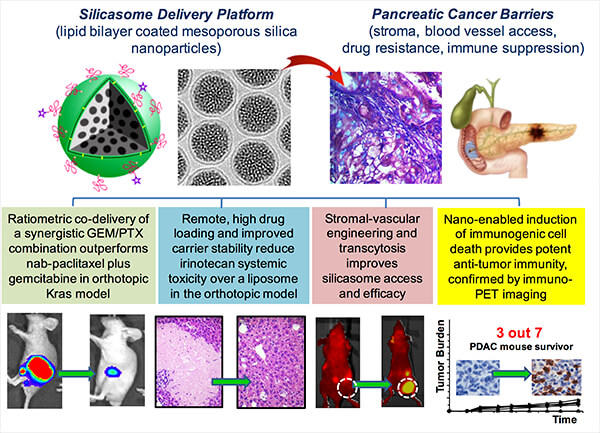University of California, Los Angeles — Mesoporous Silica Nanoparticle Platform for Treatment of Pancreas Cancer
Principal Investigators: Andre Nel, M.D., Ph.D., Timothy Donahue, M.D., Huan Meng, Ph.D., and Jeffrey Zink, Ph.D.
Co-Investigators: Caius Radu, M.D., Erkki Ruoslahti, M.D., Ph.D. (Sanford-Burnham Medical Research Institute), and Zev Wainberg, M.D.
Project Summary
Nanocarriers that circumvent the stromal barrier in pancreatic ductal adenocarcinoma (PDAC) to allow:
- ratiometric control of a synergistic gemcitabine (GEM)/paclitaxel (PTX) combination,
- overcome rate limiting steps in GEM metabolism, and
- reduce FOLFIRINOX toxicity (a potent 4-drug regimen that includes irinotecan) could significantly impact PDAC survival.
The goal of our multidisciplinary approach is to use rationally designed mesoporous silica nanoparticles (MSNP) to provide efficacious, safe and life-prolonging chemotherapy to PDAC patients. Our objectives are to develop and implement MSNP nanocarriers of which:
- achieve stable and high dose GEM and irinotecan loading, using a supported lipid bilayer (LB);
- provide synergistic PTX/GEM co-delivery, with efficacy testing in human-derived PDAC tumors and a KPC-derived model;
- provide high dose encapsulated irinotecan delivery to reduce toxicity;
- achieve carrier targeting or transcytosis by iRGD peptide, which may also prevent metastasis;
- deliver a small molecule TGF-β inhibitor (TGF-βi) that provides vascular access by interference in pericyte coverage.
Specifically, aim 1 will use LB-coated MSNP to optimize GEM delivery and efficacy in human derived PDAC tumors and a KPC-derived model. Aim 2 will demonstrate how the biocompatibility of LB-MSNP can be used to improve the toxicity profile and efficacy of irinotecan delivery in PDAC. Aim 3 will demonstrate that targeted delivery of iRGD-MSNP, promotion of nanocarrier transcytosis by iRGD co-delivery, or improvement of vascular access by TGF-βi can enhance the chemotherapeutic efficacy of MSNP nanocarriers. We expect the co-delivery of GEM / PTX and irinotecan by multifunctional MSNPs will improve survival and reduce toxicity in robust animal models. Positive impact will include the efficacious and safe nanocarriers that can be placed into the pipeline of novel diagnostics and therapeutics being tested in human PDAC. This research will also increase fundamental understanding of the PDAC microenvironment and PDAC-specific stromal barrier.
Project Expertise
The team include expertise in nanomedicine/nanosafety (Nel), pharmaceutical science/chemistry (Meng), nanomaterial chemistry (Zink), and surgery (Donahue). The team also includes expertise in cancer pharmacology/PET imaging (Radu), oncology (Wainberg) and cancer/vascular biology (Ruoslahti).
